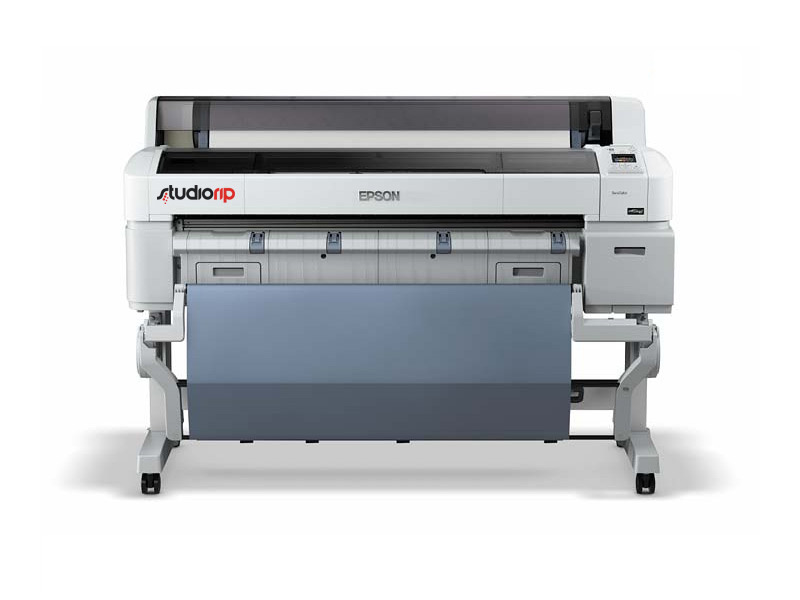CTF (Computer to Film) system that produces film for screen printing, flexography or tampography. Laser quality, cheap consumables (5$/sqm).
STUDIORIP DROPLET TO FILM 24/36/44
HOW TO BUY?
Testing
Call us for free film samples of 70, 85, 100, 133 and 150 lpi. Visit our showroom to see the equipment in live.
Buying
Contact us or our dealer network by e-mail or phone for prices.
TECHNOLOGY
StudioRIP DTF 24/36/44 is a CTF (Computer to Film) system that uses an inkjet printer to produce films for the pre-press industry (screen printing, flexography, tampography). The used film is similar to the imagesetter film, but instead of the photosensitive emulsion it has an inkjet coating is able to absorb a large quantity of ink. The system obtains densities of DMax = 4.5 and line screens up to 150 lpi. The film is imported by StudioRIP Ltd.
The film doesn’t need processing, can be used right after printing.
COMPONENTS
The printer:
- DTF 24: Epson SureColor T3200 for max. 61 cm wide film, or
- DTF 36: Epson SureColor T5200 for max. 90 cm wide film, or
- DTF 44: Epson SureColor T7200 for max. 111 wide film cm.
2. A StudioRIP XF Inkjet Edition license of the right size
SPECIFICATIONS
Resolution (the number of droplets that can be printed on one inch):
- 2880 × 2880 dpi
Line screen (the number of halftone dots per inch):
- 133, 150 and 175 lpi (recommended line screen: 175 lpi)
Speed
- Approx. 8–10 A3 plates per hour (the printing time increases with the printed area)
Relative registration precision (maximum registration error on the optimal alignment of the marks):
- Typical: 0,025 mm, maximum: 0,1 mm for 430 × 550 mm plates
- Typical: 0,05 mm, maximum: 0,2 mm for 430 × 550 mm plates
Geometrical precision (length error compared to a ruler):
- Typical: 0,1 mm, maximum: 0,2 mm
Color precision after calibration (density difference between measured and nominal values):
- Typical: ±1.5% (e.g. 50% measures between 48,5–51,5%), maximum: ±3%
Text quality:
- Very difficult to distinguish from laser plates; similar or even better quality than plates made with film.
Halftone quality:
- Very difficult to distinguish from laser plates; similar or even better quality than plates made with film.
Other quality related phenomenons:
- the smallest halftone dot is of 35–40 microns (therefore shades under 5% use hybrid screening); these dots are very difficult to see with naked eye, but offer better printing stability
- the uniformity of the dots isn’t perfect (similar to plates made with film, under the microscope a slight size and shape variation can be seen), causing slightly «noisier» halftones; on the final print this is almost impossible to distinguish from prints made with laser films though.
ADVANTAGES AND DISADVANTAGES
The advantages of StudioRIP DTP compared to an imagesetter:
- The imagesetters on the market are very old (starting from 2000 there are almost no imagesetters manufactured), while StudioRIP DTF is new and in warranty.
- Imagsetter films need processing, while StudioRIP DTF films can be used right after printing.
- The reliability is better due to the fact that it is a very simple system.
- The operation is very simple (similar to using a desktop printer), no traning is necessary for the operator.
- The maintenance is little and simple (basically the print head needs a regular check and cleaning if necessary, and the plate processor needs cleaning).
- The typical problems of laser systems (the optical parts get dirty, the focus isn’t uniform on the film, the laser power decreases etc.) are impossible with StudioRIP DTP: the print head doesn’t change its properties neither in time or geometrically (the image quality is uniform across the film).
- The system is compact, fits into a pre-press office corner.
- The system can be used as a proofer (calibrated with spectrophotometer, the proofer license included in the price).
- The system can be used as a generic color printer (banners, posters etc.)
Disadvantages of StudioRIP DTF compared to an imagesetter:
- The line screens are limited to 150 lpi (while most imagesetters go easily above 200 lpi), most technologies needing film don’t need more than 150 lpi anyway (screen printing generally uses up to 70–100 lpi).
- The speed of 10 A3 films/hour is under the speed of most imagesetters (although DTF is also able to achieve higher speeds on low line screens).
- The registration might be poor (up to 0,5–1 mm) on very large films (but this is a problem only for process color jobs).
- Under the microscope it can be seen that the halftone dots – although sharp and round – are slightly less perfect than on imagesetter films.

